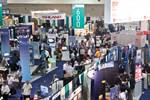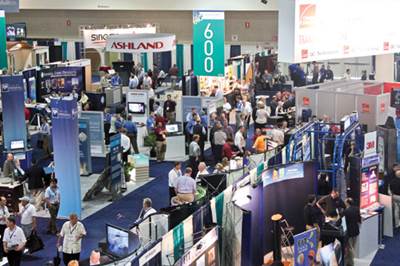Retired U.S. Army general Stanley McChrystal, who until mid-2010 was the commander of the international armed force in Afghanistan, spoke to a standing-room-only crowd at COMPOSITES 2011. His keynote comments centered on leadership and change management.
McChrystal, who now teaches at Yale University, led off with a thank-you to the composites industry, noting the critical protective role composites-based vehicle and personnel armor plays in helping keep American soldiers safe in the Iraq and Afghanistan conflicts. He then shifted to the focus of his speech, which he called “plywood leadership” — the belief that good leadership helps build human systems that are, like plywood (or, for that matter, composites), greater than the sum of their parts. Such leadership, he noted, was lacking in the lead-up to the 9/11 terrorist attacks (“We had the intel to stop the attacks”) and the 2008 financial crisis that triggered the current economic meltdown.
“We’re desperate for leaders in America,” he noted, emphasizing a three-prong leadership strategy that encompasses a keen focus on problems, a willingness to embrace change and the ability to build trust. More concretely, McChrystal believes that good leaders must first identify and actually solve complex problems, implement change and understand how leadership affects other humans.
He illustrated many of his points via anecdotes about his service in the Middle East and, in particular, in Afghanistan, using the histories and cultures of this region to highlight different perspectives on the chronic misunderstandings between the citizens in those regions and American citizens. He noted, for example, that many Afghans believe that they, during their long war with the Soviet Union in the 1980s, effectively fought the Cold War for the West. The Afghanistan that survived the conflict, after millions of its people died and its infrastructure was devastated, has endured more years of internal conflict, massive instability and a complete lack of confidence — all of which, says McChrystal, gives Afghans a predominantly negative view of the U.S. Conversely, he said, America, which funded the war against the Soviet Union, believes it did Afghans a favor. “I argue,” he said, “that you can fly countries into the ground when you lose perspective.”
Although the ability to view problems from more than one perspective is critical and might lead to a change in behavior or problem solving, McChrystal believes the ultimate arbiter of change is the lack of status quo effectiveness. To highlight this, he noted the American tendency at the start of the Iraq conflict to impose on terrorists an organizational structure that mirrors those commonly found the West: a single leader, with several subordinates who have subordinates beneath them, and so on.
What he found in terrorist organizations, however, was a loose network of associations in which neither leadership nor decision making is centralized. Deciding that “it takes a network to defeat a network,” McChrystal reorganized his own command structure to mirror that of the terrorists. In centralized decision making, he said, senior people with access to inadequate information try (and often fail) to make decisions, but he believes that information must be pushed out into the network to the field of action and that soldiers should be empowered to make the decisions.
In their management of people, McChrystal believes strongly that leaders must develop and cultivate relationships. In Afghanistan, he made heavy use of videoconferencing to bring together people in multiple regions for daily field reports. To build trust and engage “teammates,” McChrystal said he made liberal use of one basic question — “What do you think?” — which he believes demonstrates a leader’s ability to listen and see other perspectives. “Relationships require work — honest, earnest, genuine effort,” he said. “Relationships give durability to an organization.”
Related Content
Carbeon C/C-SiC ceramic matrix composites without fiber coating
Dutch startup Arceon is working with leaders in space, hypersonics and industry to test its Carbeon CMC, validating near-net-shape parts with <3% porosity and performance at 1600ºC, targeting UHTCMC and a presence in the U.S. in 2025.
Read MoreThe AAMMC Tech Hub: Ramping U.S. production of large thermoplastic composite aerostructures
CW talks with Syensqo, Spirit AeroSystems and other consortia members about current funding, specification of the next world’s largest press, organizational structure and projects to support U.S. companies in the race to deliver >40,000 sustainable and efficient aircraft over the next 20 years.
Read MoreCall for abstracts: CW Tech Days to explore high-temperature composite solutions
The fall 2025 installment of CW’s Tech Days online event series will cover high-temperature composite solutions for defense and space applications.
Read MoreSyensqo composites demonstrate titanium replacement on Boeing MQ-25 Stingray
Validation of integrating Cycom 5250-4HT prepreg into the UAV’s exhaust nozzle structure underpins the material system’s use in other high-temperature aerospace applications.
Read MoreRead Next
COMPOSITES 2011 Product Showcase
Composite Technology magazine's review of the goings-on at COMPOSITES 2011, this year’s edition of the American Composites Manufacturers Assn.’s (ACMA, Arlington, Va.) annual trade show and conference (Feb. 2-4, Greater Ft. Lauderdale Convention Center, Fla.).
Read MoreAll-recycled, needle-punched nonwoven CFRP slashes carbon footprint of Formula 2 seat
Dallara and Tenowo collaborate to produce a race-ready Formula 2 seat using recycled carbon fiber, reducing CO2 emissions by 97.5% compared to virgin materials.
Read MoreVIDEO: High-volume processing for fiberglass components
Cannon Ergos, a company specializing in high-ton presses and equipment for composites fabrication and plastics processing, displayed automotive and industrial components at CAMX 2024.
Read More












